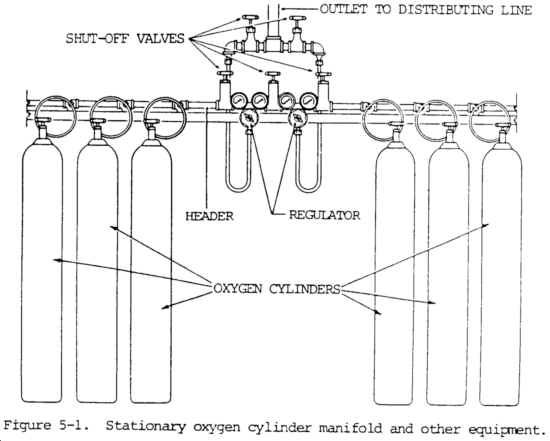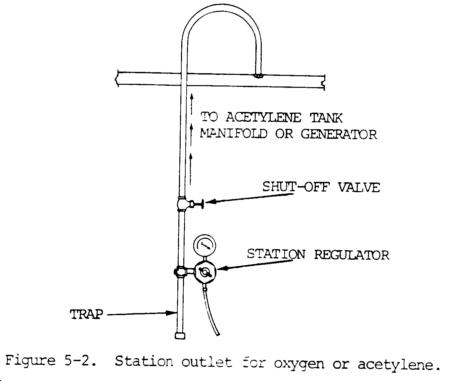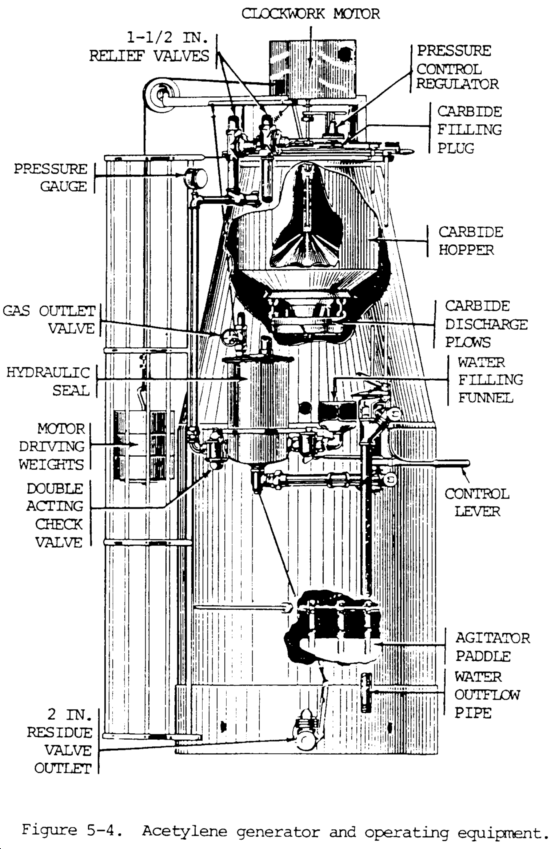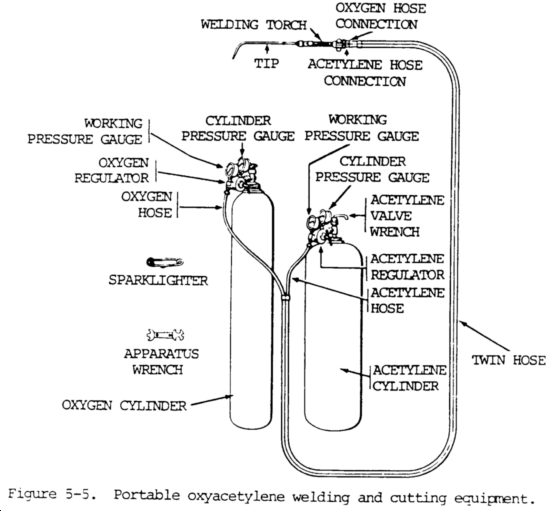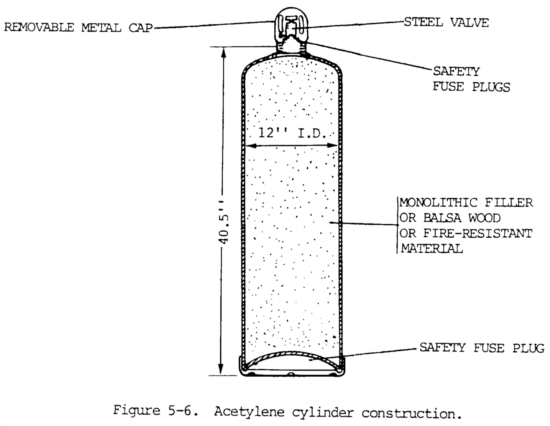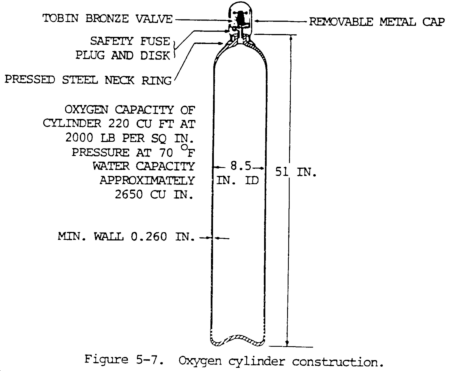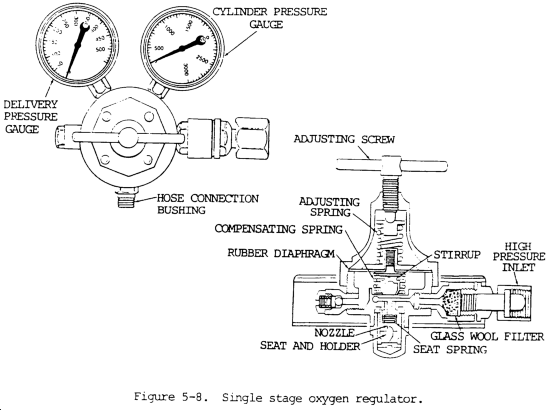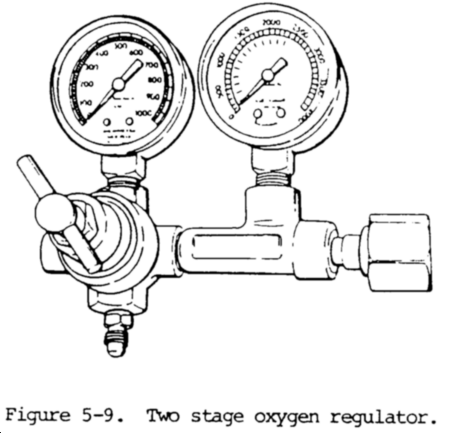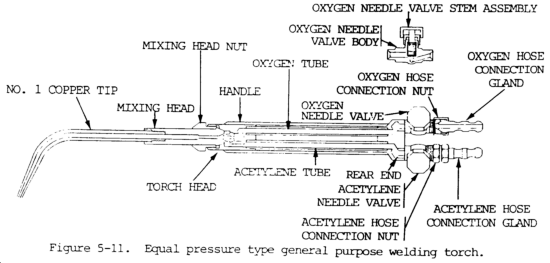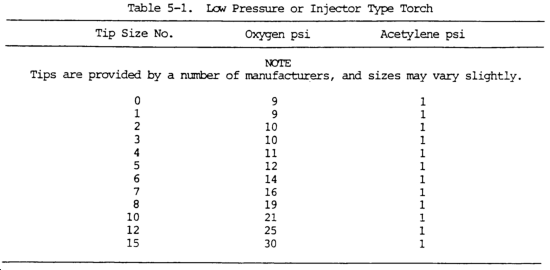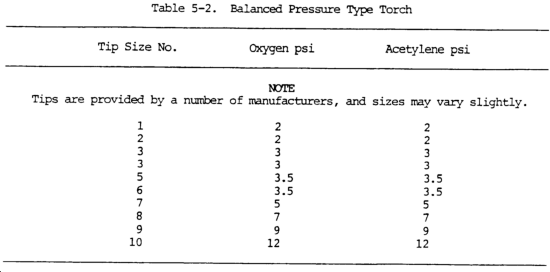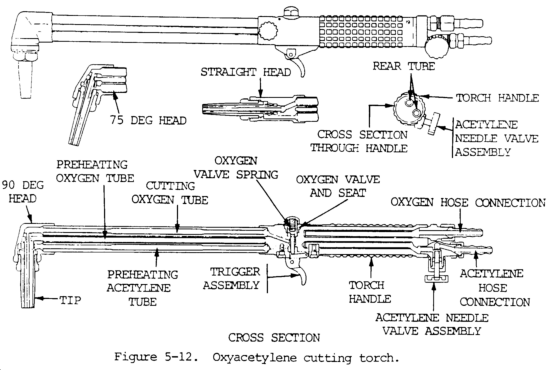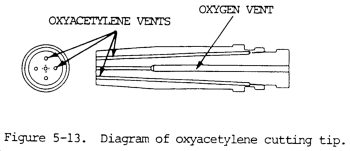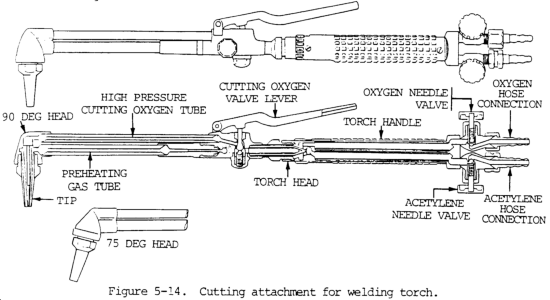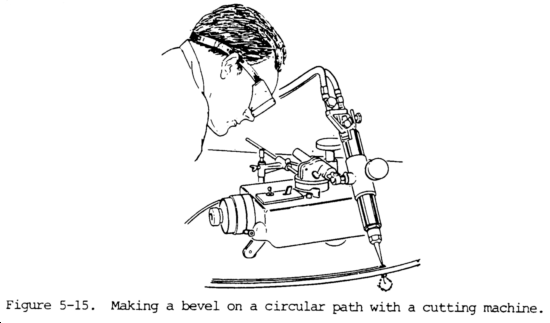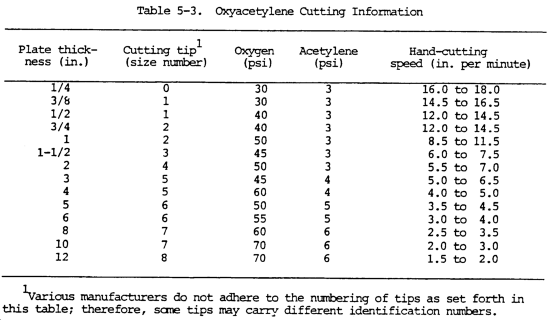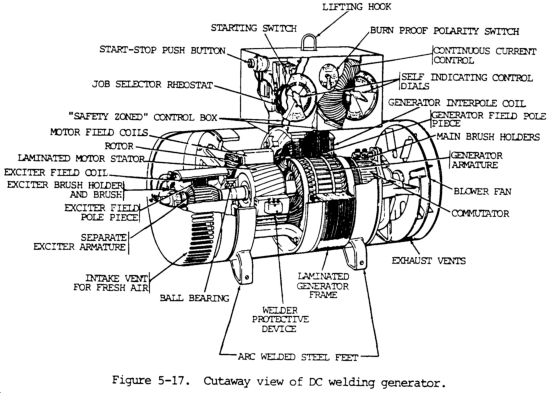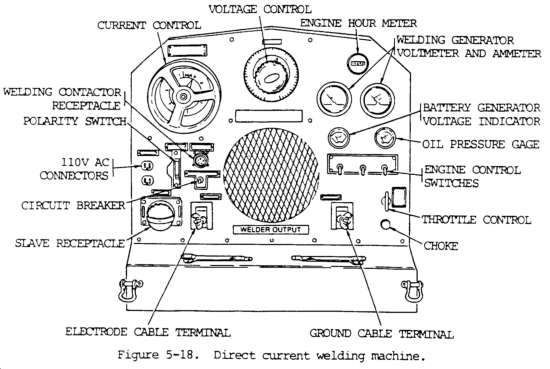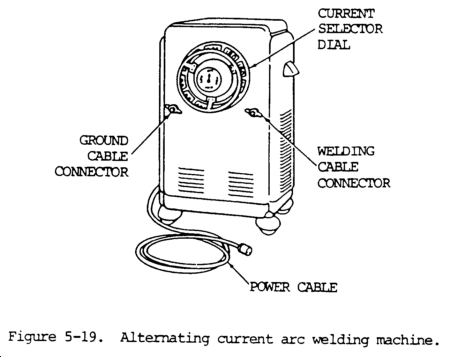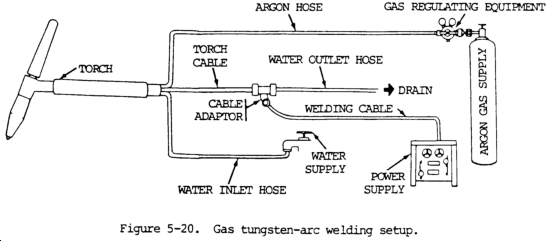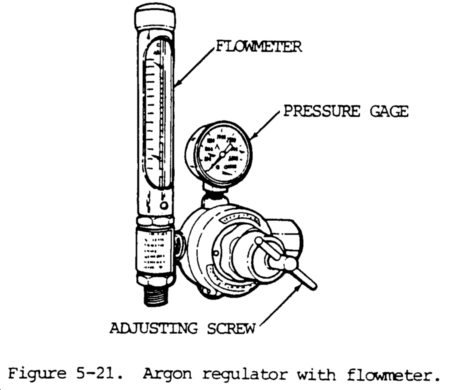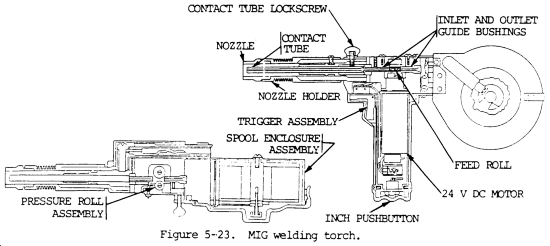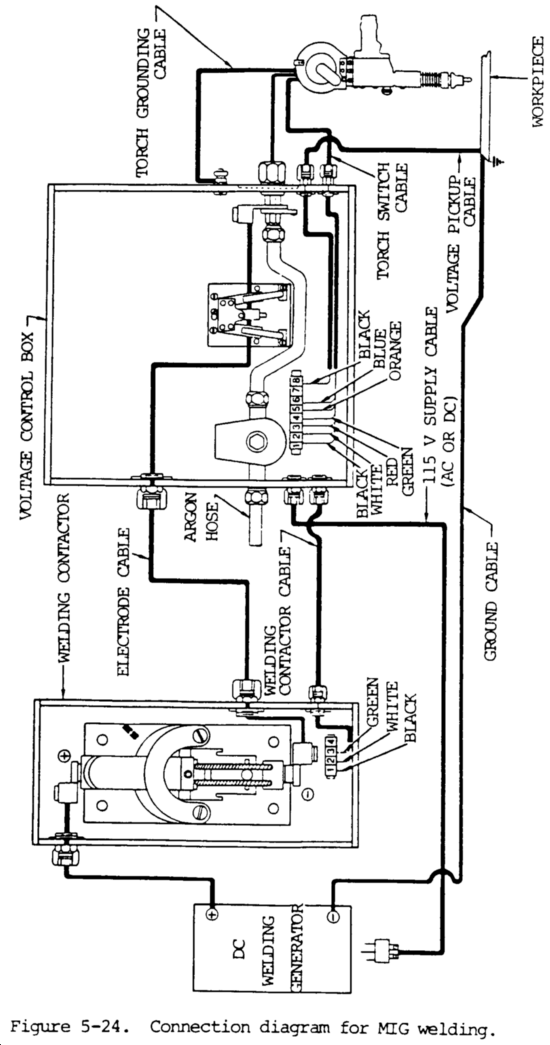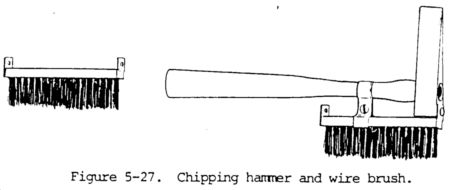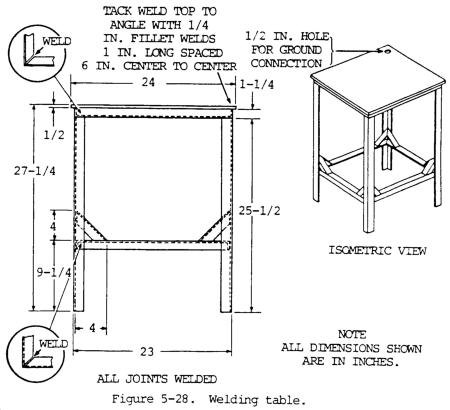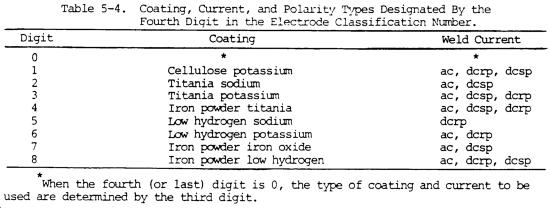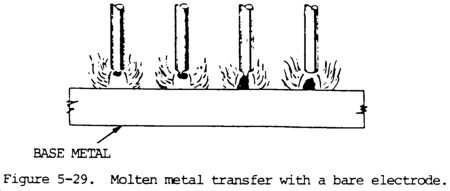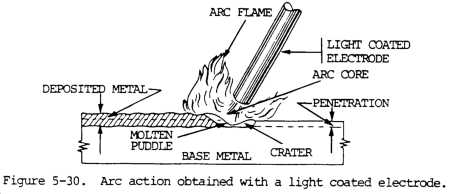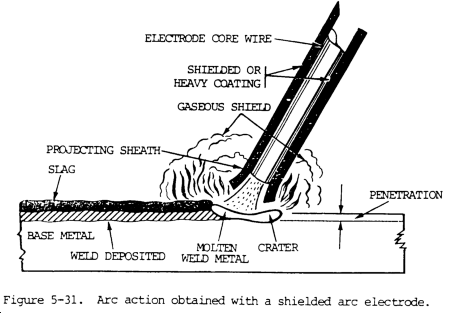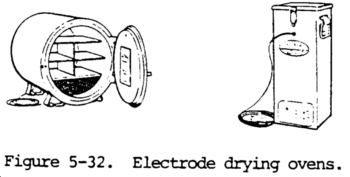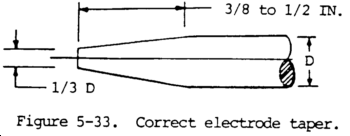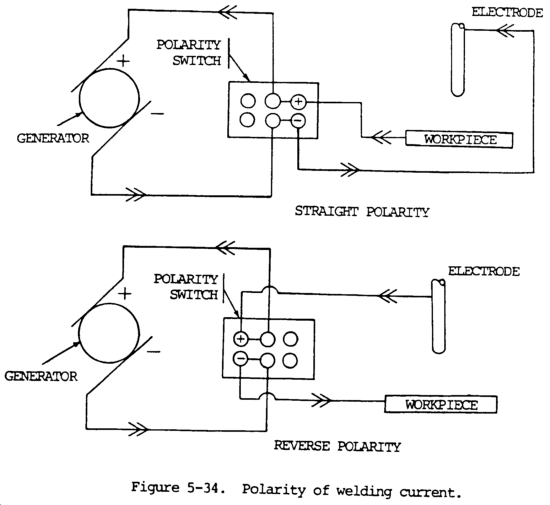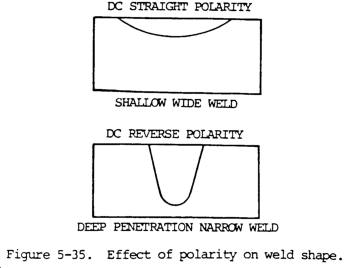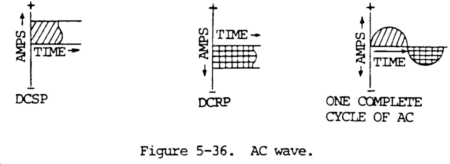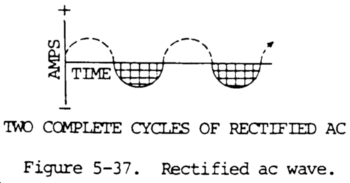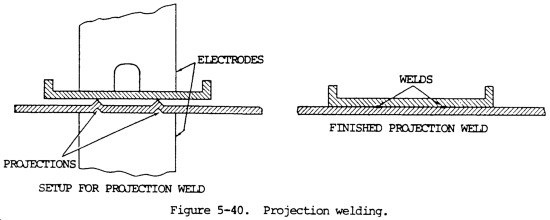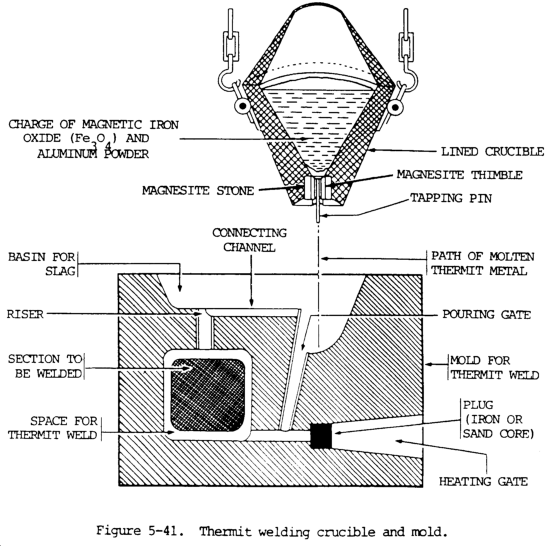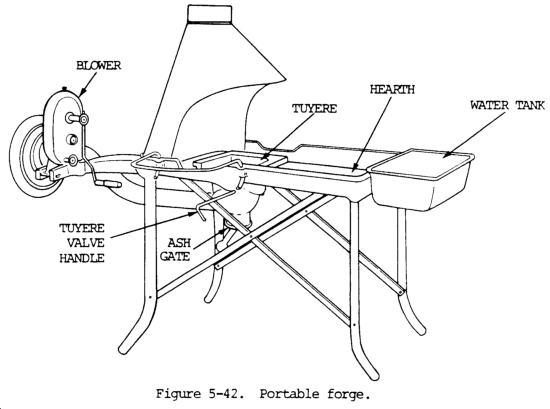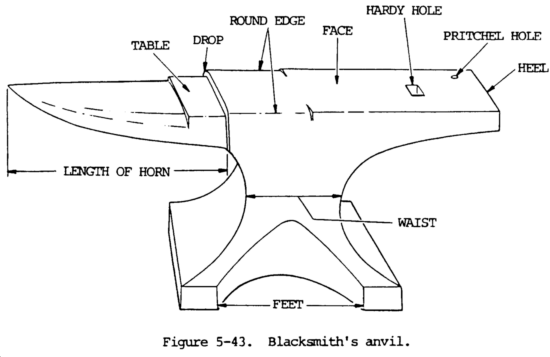CHAPTER 5
WELDING AND CUTTING EQUIPMENT
Section I. OXYACETYLENE WELDING EQUIPMENT
5-1. GENERAL
The equipment used for oxyacetylene welding consists of a source of oxygen and a source of acetylene from a portable or stationary outfit, along with a cutting attachment or a separate cutting torch. Other equipment requirements include suitable goggles for eye protection, gloves to protect the hands, a method to light the torch, and wrenches to operate the various connections on the cylinders, regulators, and torches.
5-2. STATIONARY WELDING EQUIPMENT
Stationay welding equipment is installed where welding operations are conducted in a fixed location. Oxygen and acetylene are provided in the welding area as outlined below.
a. Oxygen. Oxygen is obtained from a number of cylinders manifolded and equipped with a master regulator. The regulator and manifold control the pressure and the flow together (fig. 5-1). The oxygen is supplied to the welding stations through a pipe line equipped with station outlets (fig. 5-2).b. Acetylene. Acetylene is obtained either from acetylene cylinders set up as shown in figure 5-3, or an acetylene generator (fig. 5-4). The acetylene is supplied to the welding stations through a pipe line equipped with station outlets as shown in figure 5-2.
5-3. PORTABLE WELDING EQUIPMENT
The portable oxyacetylene welding outfit consists of an oxygen cylinder and an acetylene cylinder with attached valves, regulators, gauges, and hoses (fig. 5-5). This equipment may be temporarily secured on the floor or mounted on an all welded steel truck. The trucks are equipped with a platform to support two large size cylinders. The cylinders are secured by chains attached to the truck frame. A metal toolbox, welded to the frame, provides storage space for torch tips, gloves, fluxes, goggles, and necessary wrenches.
5-4. ACETYLENE GENERATOR
NOTE
Acetylene generator equipment is not a standard included in this manual for information only.
a. Acetylene is a fuel gas composed of carbon and hydrogen (C2H2), generated by the action of calcium carbide, a gray stonelike substance, and water in a generating unit. Acetylene is colorless, but has a distinctive odor that can be easily detected.
b. Mixtures of acetylene and air, containing from 2 to 80 percent acetylene by volume, will explode when ignited. However, with suitable welding equipment and proper precautions, acetylene can be safely burned with oxygen for heating, welding, and cutting purposes.
c. Acetylene, when burned with oxygen, produces an oxyacetylene flame with inner; cone tip temperatures of approximately 6300°F (3482°C), for an oxidizing flame; 5850°F (3232°C) for a neutral flame; and 5700°F (3149°C) for a carburizing flame.
d. The generator shown in figure 5�4 is a commonly used commercial type. A single rated 300-lb generator uses 300 lb of calcium carbide and 300 gal. of water. This amount of material will generate 4.5 cu ft of acetylene per pound; the output for this load is approximately 300 cu ft per hour for 4.5 hours. A double rated generator uses 300 lb of finer sized calcium carbide fed through a special hopper and will deliver 600 cu ft of acetylene per hour for 2.5 hours.
CAUTION
Since considerable heat is given off during the reaction, precautions must be taken to prevent excessive pressures in the generator which might cause fires or explosions.
e. In the operation of the generator, the calcium carbide is added to the water through a hopper mechanism at a rate which will maintain a working pressure of approximately 15 psi (103.4 kPa). A pressure regulator is a built-in part of this equipment. A sludge, consisting of hydrated or slaked lime, settles in the bottom of the generator and is removed by means of a sludge outlet.
5-5. ACETYLENE CYLINDERS
WARNING
Acetylene, stored in a free state under pressure greater than 15 psi (103.4 kPa), can break down from heat or shock, and possibly explode. Under pressure of 29.4 psi (203) kPa), acetylene becomes self-explosive, and a slight shock can cause it to explode spontaneously.
CAUTION
Although acetylene is nontoxic, it is an anesthetic, and if present in a sufficiently high concentration, is an asphyxiant in that it replaces oxygen and can produce suffocation.
a. Acetylene is a colorless, flammable gas composed of carbon and hydrogen, manufactured by the reaction of water and calcium carbide. It is slightly lighter than air. Acetylene burns in the air with an intensely hot, yellow, luminous, smoky flame.
b. Although acetylene is stable under low pressure, if compressed to 15 psi (103.4 kPa), it becomes unstable. Heat or shock can cause acetylene under pressure to explode. Avoid exposing filled cylinders to heat, furnaces, radiators, open fires, or sparks (from a torch). Avoid striking the cylinder against other objects and creating sparks. To avoid shock when transporting cylinders, do not drag, roll, or slide them on their sides. Acetylene can be compressed into cylinders when dissolved in acetone at pressures up to 250 psi (1724 kPa).
c. For welding purposes, acetylene is contained in three common cylinders with capacities of 1, 60, 100, and 300 cu ft. Acetylene must not be drawn off in volumes greater than 1/7 of the cylinder�s rated capacity.
d. In order to decrease the size of the open spaces in the cylinder, acetylene cylinders (fig. 5-6) are filled with porous materials such as balsa wood, charcoal, corn pith, or portland cement. Acetone, a colorless, flammable liquid, is added to the cylinder until about 40 percent of the porous material is saturated. The porous material acts as a large sponge which absorbs the acetone, which then absorbs the acetylene. In this process, the volume of acetone increases as it absorbs the acetylene, while acetylene, being a gas, decreases in volume.
CAUTION
Do not fill acetylene cylinders at a rate greater than 1/7 of their rated capacity, or about 275 cu ft per hour. To prevent drawing off of acetone and consequent impairment of weld quality and damage to the welding equipment, do not draw acetylene from a cylinder at continuous rates in volumes greater than 1/7 of the rated capacity of the cylinder, or 32.1 cu ft per hour. When more than 32.1 cu ft per hour are required, the cylinder manifold system must be used.
e. Acetylene cylinders are equipped with safety plugs (fig. 5-6) which have a small hole through the center. This hole is filled with a metal alloy which melts at approximately 212°F (100°C), or releases at 500 psi (3448 kPa). When a cylinder is overheated, the plug will melt and permit the acetylene to escape before dangerous pressures can be developed. The plug hole is too small to permit a flame to burn back into the cylinder if escaping acetylene is ignited.
f. The brass acetylene cylinder valves have squared stainless steel valve stems. These stems can be fitted with a cylinder wrench and opened or closed when the cylinder is in use. The outlet of the valve is threaded for connection to an acetylene pressure regulator by means of a union nut. The regulator inlet connection gland fits against the face of the threaded cylinder connection, and the union nut draws the two surfaces together. Whenever the threads on the valve connections are damaged to a degree that will prevent proper assembly to the regulator, the cylinder should be marked and set aside for return to the manufacturer.
WARNING
Acetylene which may accumulate in a storage room or in a confined space is a fire arid explosion hazard. All acetylene cylinders should be checked, using a soap solution, for leakage at the valves and safety fuse plugs.
g. A protective metal cap (fig. 5-6) screws onto the valve to prevent damage during shipment or storage.
h. Acetylene, when used with oxygen, produces the highest flame temperature of any of the fuel gases. It also has the most concentrated flame, but produces less gross heat of combustion than the liquid petroleum gases and the synthetic gases.
5-6. OXYGEN AND ITS PRODUCTION
a. General. Oxygen is a colorless, tasteless, odorless gas that is slightly heavier than air. It is nonflammable but will support combustion with other elements. In its free state, oxygen is one of the most common elements. The atmosphere is made up of approximately 21 parts of oxygen and 78 parts of nitrogen, the remainder being rare gases. Rusting of ferrous metals, discoloration of copper, and the corrosion of aluminum are all due to the action of atmospheric oxygen, known as oxidation.
b. Production of Oxygen. Oxygen is obtained commercially either by the liquid air process or by the electrolytic process.
(1) In the liquid air process, air is compressed and cooled to a point where the gases become liquid. As the temperature of the liquid air rises, nitrogen in a gaseous form is given off first, since its boiling point is lower than that of liquid oxygen. These gases, having been separated, are then further purified and compressed into cylinders for use. The liquid air process is by far the most widely used to produce oxygen.
(2) In the electrolytic process, water is broken down into hydrogen and oxygen by the passage of an electric current. The oxygen collects at the positive terminal and the hydrogen at the negative terminal. Each gas is collected and compressed into cylinders for use.
5-7. OXYGEN CYLINDER
CAUTION
Always refer to oxygen as oxygen, never as air. Combustibles should be kept away from oxygen, including the cylinder, valves, regulators, and other hose apparatus. Oxygen cylinders and apparatus should not be handled with oily hands or oily gloves. Pure oxygen will support and accelerate combustion of almost any material, and is especially dangerous in the presence of oil and grease. Oil and grease in the presence of oxygen may spontaneously ignite and burn violently or explode. Oxygen should never be used in any air tools or for any of the purposes for which compressed air is normally used.
A typical oxygen cylinder is shown in figure 5-7. It is made of steel and has a capacity of 220 cu ft at a pressure of 2000 psi (13,790 kPa) and a temperature of 70°F (21°C). Attached equipment provided by the oxygen supplier consists of an outlet valve, a removable metal cap for the protection of the valve, and a low melting point safety fuse plug and disk. The cylinder is fabricated from a single plate of high grade steel so that it will have no seams and is heat treated to achieve maximum strength. Because of their high pressure, oxygen cylinders undergo extensive testing prior to their release for work, and must be periodically tested thereafter.
5-8. OXYGEN AND ACETYLENE REGULATORS
a. General. The gases compressed in oxygen and acetylene cylinders are held at pressures too high for oxyacetylene welding. Regulators reduce pressure and control the flow of gases from the cylinders. The pressure in an oxygen cylinder can be as high as 2200 psi (15,169 kPa), which must be reduced to a working pressure of 1 to 25 psi (6.90 to 172.38 kPa). The pressure of acetylene in an acetylene cylinder can be as high as 250 psi (1724 kPa). A gas pressure regulator will automatically deliver a constant volume of gas to the torch at the adjusted working pressure.
NOTE
The regulators for oxygen, acetylene, and liquid petroleum fuel gases are of different construction. They must be used only for the gas for which they were designed.
Most regulators in use are either the single stage or the two stage type. Check valves must be installed between the torch hoses and the regulator to prevent flashback through the regulator.
b. Single Stage Oxygen Regulator.
The single stage oxygen regulator reduces the cylinder pressure of a gas to a working pressure in one step. The single stage oxygen regulator mechanism (fig. 5-8) has a nozzle through which the high pressure gas passes, a valve seat to close off the nozzle, and balancing springs. Some types have a relief valve and an inlet filter to exclude dust and dirt. Pressure gauges are provided to show the pressure in the cylinder or pipe line and the working pressure.
NOTE
In operation, the working pressure falls as the cylinder pressure falls, which occurs gradually as gas is withdrawn. For this reason, the working pressure must be adjusted at intervals during welding operations when using a single stage oxygen regulator.
The oxygen regulator controls and reduces the oxygen pressure from any standard commercial oxygen cylinder containing pressures up to 3000 psi. The high pressure gauge, which is on the inlet side of the regulator, is graduated from 0 to 3000 psi. The low or working pressure gauge, which is on the outlet side of the regulator, is graduated from 0 to 500 psi.
c. Operation of Single Stage Oxygen Regulator.
(1) The regulator consists of a flexible diaphragm, which controls a needle valve between the high pressure zone and the working zone, a compression spring, and an adjusting screw, which compensates for the pressure of the gas against the diaphragm. The needle valve is on the side of the diaphragm exposed to high gas pressure while the compression spring and adjusting screw are on the opposite side in a zone vented to the atmosphere.
(2) The oxygen enters the regulator through the high pressure inlet connection and passes through a glass wool filter, which removes dust and dirt. The seat, which closes off the nozzle, is not raised until the adjusting screw is turned in. Pressure is applied to the adjusting spring by turning the adjusting screw, which bears down on the rubber diaphragm. The diaphragm presses downward on the stirrup and overcomes the pressure on the compensating spring. When the stirrup is forced downward, the passage through the nozzle is open. Oxygen is then allowed to flow into the low pressure chamber of the regulator. The oxygen then passes through the regulator outlet and the hose to the torch. A certain set pressure must be maintained in the low pressure chamber of the regulator so that oxygen will continue to be forced through the orifices of the torch, even if the torch needle valve is open. This pressure is indicated on the working pressure gage of the regulator, and depends on the position of the regulator adjusting screw. Pressure is increased by turning the adjusting screw to the right and decreased by turning this screw to the left.
(3) Regulators used at stations to which gases are piped from an oxygen manifold, acetylene manifold, or acetylene generator have only one low pressure gage because the pipe line pressures are usually set at 15 psi (103.4 kPa) for acetylene and approximately 200 psi (1379 kPa) for oxygen. The two stage oxygen regulator (fig. 5�9) is similar in operation to the one stage regulator, but reduces pressure in two steps. On the high pressure side, the pressure is reduced from cylinder pressure to intermediate pressure. On the low pressure side the pressure is reduced from intermediate pressure to work pressure. Because of the two stage pressure control, the working pressure is held constant, and pressure adjustment during welding operations is not required.
e. Acetylene Regulator.
CAUTION
Acetylene should never be used at pressures exceeding 15 psi (103.4 kPa).
This regulator controls the acetylene pressure from any standard commercial cylinder containing pressures up to 500 psi (3447.5 kPa). The acetylene regulator design is generally the same as that of the oxygen regulator, but will not withstand such high pressures. The high pressure gage, on the inlet side of the regulator, is graduated from 0 to 500 psi (3447.5 kPa). The low pressure gage, on the outlet side of the regulator, is graduated from 0 to 30 psi (207 kPa). Acetylene should not be used at pressures exceeding 15 psi (103.4 kPa).
5-9. OXYACETYLENE WELDING TORCH
a. General. The oxyacetylene welding torch is used to mix oxygen and acetylene in definite proportions. It also controls the volume of these gases burning at the welding tip, which produces the required type of flame. The torch consists of a handle or body which contains the hose connections for the oxygen and the fuel gas. The torch also has two needle valves, one for adjusting the flew of oxygen and one for acetylene, and a mixing head. In addition, there are two tubes, one for oxygen, the other for acetylene; inlet nipples for the attachment of hoses; a tip; and a handle. The tubes and handle are of seamless hard brass, copper-nickel alloy, stainless steel. For a description and the different sized tips, see paragraph 5-10.
b. Types of Torches. There are two general types of welding torches; the low pressure or injector type, and the equal pressure type.
(1) In the low pressure or injector type (fig. 5-10), the acetylene pressure is less than 1 psi (6.895 kPa). A jet of high pressure oxygen is used to produce a suction effect to draw in the required amount of acetylene. Any change in oxygen flow will produce relative change in acetylene flow so that the proportion of the two gases remains constant. This is accomplished by designing the mixer in the torch to operate on the injector principle. The welding tips may or may not have separate injectors designed integrally with each tip.
(2) The equal pressure torch (fig. 5-11) is designed to operate with equal pressures for the oxygen and acetylene. The pressure ranges from 1 to 15 psi (6.895 to 103.4 kPa). This torch has certain advantages over the low pressure type. It can be more readily adjusted, and since equal pressures are used for each gas, the torch is less susceptible to flashbacks.
a. The welding tips (fig. 5-10 and 5-11) are made of hard drawn electrolytic or 95 percent copper and 5 percent tellurium. They are made in various and types, some having a one-piece tip either with a single orifice or a of orifices. The diameters of the tip orifices differ in order to control the quantity of heat and the type of flame. These tip sizes are designated by numbers which are arranged according to the individual manufacturer�s system. Generally, the smaller the number, the smaller the tip orifice.
b. Mixers (fig. 5-10 and 5-11) are frequently provided in tip tier assemblies which assure the correct flow of mixed gases for each size tip. In this tip mixer assembly, the mixer is assembled with the tip for which it has been drilled and then screwed onto the torch head. The universal type mixer is a separate unit which can be used with tips of various sizes.
5-11. HOSE
a. The hoses used to make the connection between are made especially for this purpose.
(1) Hoses are built to withstand high internal the regulators and the torch pressures.
(2) They are strong, nonporous, light, and flexible to permit easy manipulation of the torch.
(3) The rubber used in the manufacture of hose is chemically treated to remove free sulfur to avoid possible spontaneous combustion.
(4) The hose is not impaired by prolonged exposure to light.
CAUTION
Hose should never be used for one gas if it was previously used for another.
b. Hose identification and composition.
(1) In North America, the oxygen hose is green and the acetylene hose is red. In Europe, blue is used for oxygen and orange for acetylene. Black is sometimes also used for oxygen.
(2) The hose is a rubber tube with braided or wrapped cotton or rayon reinforcements and a rubber covering. For heavy duty welding and cutting operations, requiring 1/4-to 1/2-in. internal diameter hose, three to five plies of braided or wrapped reinforcements are used. One ply is used in the 1/8-to 3/16-in. hose for light torches.
c. Hoses are provided with connections at each end so that they may be connected to their respective regulator outlet and torch inlet connections. To prevent a dangerous interchange of acetylene and oxygen hoses, all threaded fittings used for the acetylene hook up are left hand, and all threaded fittings for the oxygen hook up are right hand. Notches are also placed on acetylene fittings to prevent a mixup.
d. Welding and cutting hoses are obtainable as a single hose for each gas or with the hoses bonded together along their length under a common outer rubber jacket. The latter type prevents the hose from kinking or becoming tangled during the welding operation.
5-12. SETTING UP THE EQUIPMENT
WARNING
Always have suitable fire extinguishing equipment at hand when doing any welding.
When setting up welding and cutting equipment, it is important that all operations be performed systematically in order to avoid mistakes and possible trouble. The setting up procedures given in a through d below will assure safety to the operator and the apparatus.
WARNING
Do not stand facing cylinder valve outlets of oxygen, acetylene, or other compressed gases when opening them.
(1) Place the oxygen and the acetylene cylinders on a level floor (if they are not mounted on a truck), and tie them firmly to a work bench, post, wall, or other secure anchorage to prevent their being knocked or pulled over.
(2) Remove the valve protecting caps.
(3) "Crack" both cylinder valves by opening first the acetylene and then the oxygen valve slightly for an instant to blow out any dirt or foreign matter that may have accumulated during shipment or storage.
(4) Close the valves and wipe the connection seats with a clean cloth.
b. Pressure Regulators.
(1) Check the regulator fittings for dirt and obstructions. Also check threads of cylinders and regulators for imperfections.
(2) Connect the acetylene regulator to the acetylene regulator and the oxygen regulator to the oxygen cylinder. Use either a regulator wrench or a close fitting wrench and tighten the connecting nuts sufficiently to prevent leakage.
(3) Check hose for burns, nicks, and bad fittings.
(4) Connect the red hose to the acetylene regulator and the green hose to the oxygen regulator. Screw the connecting nuts tightly to insure leakproof seating. Note that the acetylene hose connection has left hand threads.
WARNING
If it is necessary to blow out the acetylene hose, do it in a well ventilated place which is free of sparks, flame, or other sources of ignition.
(5) Release the regulator screws to avoid damage to the regulators and gages. Open the cylinder valves slowly. Read the high pressure gages to check the cylinder gas pressure. Blow out the oxygen hose by turning the regulator screw in and then release the regulator screw. Flashback suppressors must be attached to the torch whenever possible.
c. Torch. Connect the red acetylene hose to the torch needle valve which is stamped "AC or flashback suppressor". Connect the green oxygen hose to the torch needle valve which is stamped "OX or flashback suppressor". Test all hose connections for leaks at the regulators and torch valves by turning both regulators� screws in with the torch needle valves closed. Use a soap and water solution to test for leaks at all connections. Tighten or replace connections where leaks are found. Release the regulator screws after testing and drain both hose lines by opening the torch needle valves. Slip the tip nut over the tip, and press the tip into the mixing head. Tighten by hand and adjust the tip to the proper angle. Secure this adjustment by tightening with the tip nut wrench.
WARNING
Purge both acetylene and oxygen lines (hoses) prior to igniting torch. Failure to do this can cause serious injury to personnel and damage to the equipment.
d. Adjustment of Working Pressure. Adjust the acetylene working pressure by opening the acetylene needle valve on the torch and turning the regulator screw to the right. Then adjust the acetylene regulator to the required pressure for the tip size to be used (tables 5-1 and 5-2). Close the needle valve. Adjust the oxygen working pressure in the same manner.
5-13. SHUTTING DOWN WELDING APPARATUS
a. Shut off the gases. Close the acetylene valve first, then the oxygen valve on the torch. Then close the acetylene and oxygen cylinder valves.
b. Drain the regulators and hoses by the following procedures:
(1) Open the torch acetylene valve until the gas stops flowing and the gauges read zero, then close the valve.
(2) Open the torch oxygen valve to drain the oxygen regulator and hose. When gas stops flowing and the gauges read zero, close the valve.
(3) When the above operations are performed properly, both high and low pressure gauges on the acetylene and oxygen regulators will register zero.
c. Release the tension on both regulator screws by turning the screws to the left until they rotate freely.
d. Coil the hoses without kinking them and suspend them on a suitable holder or hanger. Avoid upsetting the cylinders to which they are attached.
5-14. REGULATOR MALFUNCTIONS AND CORRECTIONS
a. Leakage of gas between the regulator seat and the nozzle is the principal problem encounter with regulators. It is indicated by a gradual increase in pressure on the working pressure gauge when the adjusting screw is fully released or is in position after adjustment. This defect, called "creeping regulator", is caused by bad valve seats or by foreign matter lodged between the seat and the nozzle.
WARNING
Regulators with leakage of gas between the regulator seat and the nozzle must be replaced immediately to avoid damage to other parts of the regulator or injury to personnel. With acetylene regulators, this leakage is particularity dangerous because acetylene at high pressure in the hose is an explosion hazard.
b. The leakage of gas, as described above, can be corrected as outlined below:
(1) Remove and replace the seat if it is worn, cracked, or otherwise damaged.
(2) If the malfunction is caused by fouling with dirt or other foreign matter, clean the seat and nozzle thoroughly and blow out any dust or dirt in the valve chamber.
c. The procedure for removing valve seats and nozzles will vary with the make or design.
d. Broken or buckled gage tubes and distorted or buckled diaphragms are usually caused by backfire at the torch, leaks across the regulator seats, or by failure to release the regulator adjusting screw fully before opening the cylinder valves.
e. Defective bourdon tubes in the gages are indicated by improper action of the gages or by escaping gas from the gage case. Gages with defective bourdon tubes should be removed and replaced with new gages. Satisfactory repairs cannot be made without special equipment.
f. Buckled or distorted diaphragms cannot be adjusted properly and should be replaced with new ones. Rubber diaphragms can be replaced easily by removing the spring case with a vise or wrench. Metal diaphragms are sometimes soldered to the valve case and their replacement is a factory or special repair shop job. Such repairs should not be attempted by anyone unfamiliar with the work.
5-15. TORCH MALFUNCTIONS AND CORRECTIONS
WARNING
Defects in oxyacetylene welding torches which are sources of gas leaks must be corrected immediately, as they may result in flashbacks or backfires, with resultant injury to the operator and/ or damage to the welding apparatus.
a. General. Improved functioning of welding torches is usually due to one or more of the following causes: leaking valves, leaks in the mixing head seat, scored or out-of-round welding tip orifices, clogged tubes or tips, and damaged inlet connection threads. Corrective measures for these common torch defects are described below.
(1) Bent or worn valve stems should be replaced and damaged seats should be refaced.
(2) Loose packing may be corrected by tightening the packing nut or by installing new packing and then tightening the packing nut.
CAUTION
This work should be done by the manufacturer because special reamers are required for trueing these seats.
c. Leaks in the Mixing Heads. These are indicated by popping out of the flame and by emission of sparks from the tips accompanied by a squealing noise. Leaks in the mixing head will cause improper mixing of the oxygen and acetylene causing flashbacks. A flashback causes the torch head and handle to suddenly become very hot. Repair by reaming out and trueing the mixing head seat.
d. Scored or Out-of-Round Tip Orifices. Tips in this condition cause the flame to be irregular and must be replaced.
e. Clogged Tubes and Tips.
(1) Carbon deposits caused by flashbacks or backfire, or the presence of foreign matter that has entered the tubes through the hoses will clog tubes. If the tubes or tips are clogged, greater working pressures will be needed to produce the flame required. The flame produced will be distorted.
(2) The torch should be disassembled so that the tip, mixing head, valves, and hose can be cleaned and cleaned out with compressed air at a pressure of 20 to 30 psi (137.9 to 206.85 kPa).
(3) The tip and mixing head should be cleaned either with a cleaning drill or with soft copper or brass wire, and then blown out with compressed air. The cleaning drills should be approximately one drill size smaller than the tip orifice to avoid enlarging the orifice during cleaning.
WARNING
Damages inlet connection threads may cause fires by ignition of the leaking gas, resulting in injury to the welding operator and/or damage to the equipment.
f. Damaged Inlet Connection Threads. Leaks due to damaged inlet connection threads can be detected by opening the cylinder valves and keeping the needle valves closed. Such leaks will cause the regulator pressure to drop. Also, if the threads are damaged, the hose connection at the torch inlet will be difficult or impossible to tighten. To correct this defect, the threads should be recut and the hose connections thoroughly cleaned.
Section II. OXYACETYLENE CUTTING EQUIPMENT5-16. CUTTING TORCH AND OTHER CUTTING EQUIPMENT
a. The cutting torch (fig. 5-12), like the welding torch, has a tube for oxygen and one for acetylene. In addition, there is a tube for high pressure oxygen, along with a cutting tip or nozzle. The tip (fig. 5-13) is provided with a center hole through which a jet of pure oxygen passes. Mixed oxygen and acetylene pass through holes surrounding the center holes for the preheating flames. The number of orifices for oxyacetlylene flames ranges from 2 to 6, depending on the purpose for which the tip is used. The cutting torch is controlled by a trigger or lever operated valve. The cutting torch is furnished with interchangeable tips for cutting steel from less than 1/4 in. (6.4 mm) to more than 12.0 in. (304.8 mm) in thickness.
b. A cutting attachment fitted to a welding torch in place of the welding tip is shown in figure 5-14.
c. In order to make uniformly clean cuts on steel plate, motor driven cutting machines are used to support and guide the cutting torch. Straight line cutting or beveling is accomplished by guiding the machine along a straight line on steel tracks. Arcs and circles are cut by guiding the machine with a radius rod pivoted about a central point. Typical cutting machines in operation are shown in figures 5-15 and 5-16.
d. There is a wide variety of cutting tip styles and sizes available to suit various types of work. The thickness of the material to be cut generally governs the selection of the tip. The cutting oxygen pressure, cutting speed, and preheating intensity should be controlled to produce narrow, parallel sided kerfs. Cuts that are improperly made will produce ragged, irregular edges with adhering slag at the bottom of the plates. Table 5-3 identifies cutting tip numbers, gas pressures, and hand-cutting speeds used for cutting mild steel up to 12 in. (304.8 mm) thick.
5-17. OPERATION OF CUTTING EQUIPMENT
a. Attach the required cutting tip to the torch and adjust the oxygen and acetylene pressures in accordance with table 5-3.
NOTE
The oxygen and acetylene gas pressure settings listed are only approximate. In actual use, pressures should be set to effect the best metal cut.
b. Adjust the preheating flame to neutral.
c. Hold the torch so that the cutting oxygen lever or trigger can be operated with one hand. Use the other hand to steady and maintain the position of the torch head to the work. Keep the flame at a 90 degree angle to work in the direction of travel. The inner cones of the preheating flames should be about 1/16 in. (1.6 mm) above the end of the line to be cut. Hold this position until the spot has been raised to a bright red heat, and then slowly open the cutting oxygen valve.
d. If the cut has been started properly, a shower of sparks will fall from the opposite side of the work. Move the torch at a speed which will allow the cut to continue penetrating the work. A good cut will be clean and narrow.
e. When cutting billets, round bars, or heavy sections, time and gas are saved if a burr is raised with a chisel at the point where the cut is to start. This small portion will heat quickly and cutting will start immediately. A welding rod can be used to start a cut on heavy sections. When used, it is called a starting rod.
Section III. ARC WELDING EQUIPMENT AND ACCESSORIES
5-18. GENERAL
In electric welding processes, an arc is produced between an electrode and the work piece (base metal). The arc is formed by passing a current between the electrode and the workpiece across the gap. The current melts the base metal and the electrode (if the electrode is a consumable type), creating a molten pool. On solidifying, the weld is formal. An alternate method employs a nonconsumable electrode, such as a tungsten rod. In this case, the weld is formed by melting and solidifying the base metal at the joint. In some instances, additional metal is required, and is added to the molten pool from a filler rod.
Electrical equipment required for arc welding depends on the source from which the electric power is obtained. If the power is obtained from public utility lines, one or more of the following devices are required: transformers (of which there are several types), rectifiers, motor generators, and control equipment. If public utility power is not available, portable generators driven by gasoline or diesel engines are used.
5-19. DIRECT CURRENT ARC WELDING MACHINES
a. The direct current welding machine has a heavy duty direct current generator (fig. 5-17). The generators are made in six standardized ratings for general purposes as described below:
(2) The machines rated 200, 300, and 400 amperes, 40 volts, used for general welding purposes by machine or manual application.
(3) Machines rated 600 amperes, 40 volts, are used for submerged arc welding and for carbon-arc welding.
b. The electric motors must commonly used to drive the welding generators are 220/440 volts, 3 phase, 60 cycle. The gasoline and diesel engines should have a rated horsepower in excess of the rated output of the generator. This will allow for the rated overload capacity of the generator and for the power required to operate the accessories of the engine. The simple equation HP = 1.25P/746 can be used; HP is the engine horsepower and P is the generator rating in watts. For example, a 20 horsepower engine would be used to drive a welding generator with a rated 12 kilowatt output.
c. In most direct current welding machines, the generator is of the variable voltage type, and is arranged so that the voltage is automatically adjusted to the demands of the arc. However, the voltage may be set manually with a rheostat.
d. The welding current amperage is also manually adjustable, and is set by means of a selector switch or series of plug receptacles. In either case, the desired amperage is obtained by tapping into the generator field coils. When both voltage and amperage of the welding machine are adjustable, the machine is known as dual control type. Welding machines are also manufactured in which current controls are maintained by movement of the brush assembly.
e. A direct current welding machine is described in TM 5-3431-221-15, and is illustrated in figure 5-18.
f. A maintenance schedule should be set up to keep the welding machine in good operating condition. The machine should be thoroughly inspected every 3 months and blown free of dust with clean, dry, compressed air. At least once each year, the contacts of the motor starter switches and the rheostat should be cleaned and replaced if necessary. Brushes should be inspected frequently to see if they are making proper contact on the commutator, and that they move freely in the brush holders. Clean and true the commutator with sandpaper or a commutator stone if it is burned or roughened. Check the bearings twice a year. Remove all the old grease and replace it with new grease.
g. Direct current rectifier type welding machines have been designed with copper oxide, silicon, or selenium dry plates. These machines usually consist of a transform to reduce the power line voltage to the required 220/440 volts, 3 phase, 60 cycle input current; a reactor for adjustment of the current; and a rectifier to change the alternating current to direct current. Sometimes another reactor is used to reduce ripple in the output current.
5-20. ALTERNATING CURRENT ARC WELDING MACHINES
a. Most of the alternating current arc welding machines in use are of the single operator, static transformer type (fig. 5-19). For manual operation in industrial applications, machines having 200, 300, and 400 amphere ratings are the sizes in general use. Machines with 150 ampere ratings are sometimes used in light industrial, garage and job shop welding.
b. The transformers are generally equipped with arc stabilizing capacitors. Current control is provided in several ways. One such method is by means of an adjustable reactor in the output circuit of the transformer. In other types, internal reactions of the transformer are adjustable. A handwheel, usually installed on the front or the top of the machine, makes continuous adjustment of the output current, without steps, possible.
c. The screws and bearings on machines with screw type adjustments should be lubricated every 3 months. The same lubrication schedule applies to chain drives. Contacts, switches, relays, and plug and jack connections should be inspected every 3 months and cleaned or replaced as required. The primary input current at no load should be measured and checked once a year to ensure the power factor connecting capacitors are working, and that input current is as specified on the nameplate or in the manufacturer�s instruction book.
5-21. GAS TUNGSTEN-ARC WELDING (GTAW) EQUIPMENT (TIG)
a. General. In tungsten inert gas (TIG) welding, (also known as GTAW), an arc is struck between a virtually nonconsumable tungsten electrode and the workpiece. The heat of the arc causes the edges of the work to melt and flow together. Filler rod is often required to fill the joint. During the welding operation, the weld area is shielded from the atmosphere by a blanket of inert argon gas. A steady stream of argon passes through the torch, which pushes the air away from the welding area and prevents oxidation of the electrode, weld puddle, and heat affected zone.
b. Equipment.
(1) The basic equipment requirements for manual TIG welding are shown in figure 5-20. Equipment consists of the welding torch plus additional apparatus to supply electrical power, shielding gas, and a water inlet and outlet. Also, personal protective equipment should be worn to protect the operator from the arc rays during welding operations.
NOTE
Different types of TIG welding equipment are available through normal supply channels. Water-cooled torches and air-cooled torches are both available. Each type carries different amperage ratings. Consult the appropriate manual covering the type torch used.
(2) Argon is supplied in steel cylinders containing approximately 330 cu ft at a pressure to 2000 psi (13,790 kPa). A single or two stage regulator may be used to control the gas flow. A specially designed regulator containing a flowmeter, as shown in figure 5-21, may be used. The flowmeter provides better adjustment via flow control than the single or two stage regulator and is calibrated in cubic feet per hour (cfh). The correct flow of argon to the torch is set by turning the adjusting screw on the regulator. The rate of flow depends on the kind and thickness of the metal to be welded.
(3) Blanketing of the weld area is provided by a steady flow of argon gas through the welding torch (fig. 5-22). Since argon is slightly more than 1-1/3 times as heavy as air, it pushes the lighter air molecules aside, effectively preventing oxidation of the welding electrode, the molten weld puddle, and the heat affected zone adjacent to the weld bead.
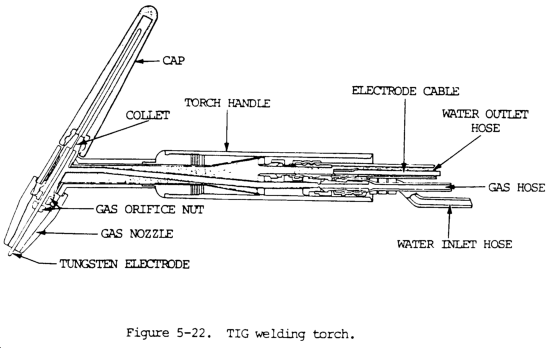
(4) The tremendous heat of the arc and the high current often used usually necessitate water cooling of the torch and power cable (fig. 5-22). The cooling water must be clean; otherwise, restricted or blocked passages may cause excessive overheating and damage to the equipment. It is advisable to use a suitable water strainer or filter at the water supply source. If a self-contained unit is used, such as the one used in the field (surge tank) where the cooling water is recirculated through a pump, antifreeze is required if the unit is to be used outdoors during the winter months or freezing weather. Some TIG welding torches require less than 55 psi (379 kPa) water pressure and will require a water regulator of some type. Check the operating manual for this information.
c. Nomenclature of Torch (fig. 5-22).
(1) Cap. Prevents the escape of gas from the top of the torch and locks the electrode in place.
(2) Collet. Made of copper; the electrode fits inside and when the cap is tightened, it squeezes against the electrode and leeks it in place.
(3) Gas orifice nut. Allows the gas to escape.
(4) Gas nozzle. Directs the flew of shielding gas onto the weld puddle. Two types of nozzles are used; the one for light duty welding is made of a ceramic material, and the one for heavy duty welding is a copper water-cooled nozzle.
(5) Hoses. Three plastic hoses, connected inside the torch handle, carry water, gas, and the electrode power cable.
5-22. GAS METAL-ARC WELDING (GMAW) EQUIPMENT
a. General. GMAW is most commonly referred to as "MIG" welding, and the following text will use "MIG" or "MIG welding" when referring to GMAW. MIG welding is a process in which a consumable, bare wire electrode is fed into a weld at a controlled rate of speed, while a blanket of inert argon gas shields the weld zone from atmospheric contamination. In addition to the three basic types of metal transfer which characterize the GMAW process, there are several variations of significance.
(1) Pulsed spray welding. Pulsed spray welding is a variation of the MIG welding process that is capable of all�position welding at higher energy levels than short circuiting arc welding. The power source provides two current levels; a steady "background" level, which is too low to produce spray transfer; and a "pulsed peak" current, which is superimposed upon the background current at a regulated interval. The pulse peak is well above the transition current, and usually one drop is transferred during each pulse. The combination of the two levels of current produces a steady arc with axial spray transfer at effective welding currents below those required for conventional spray arc welding. Because the heat input is lower, this variation in operation is capable of welding thinner sections than are practical with the conventional spray transfer.
(2) Arc spot welding. Gas metal arc spot welding is a method of joining similar to resistance spot welding and riveting. A variation of continuous gas metal arc welding, the process fuses two pieces of sheet metal together by penetrating entirely through one piece into the other. No joint preparation is required other than cleaning of the overlap areas. The welding gun remains stationary while a spot weld is being made. Mild steel, stainless steel, and aluminum are commonly joined by this method.
(3) Electrogas welding. The electrogas (EG) variation of the MIG welding process is a fully automatic, high deposition rate method for the welding of butt, corner, and T-joints in the vertical position. The eletrogas variation essentially combines the mechanical features of electroslag welding (ESW) with the MIG welding process. Water-coded copper shoes span the gap between the pieces being welded to form a cavity for the molten metal. A carriage is mounted on a vertical column; this combination provides both vertical and horizontal movement. Welding head, controls, and electrode spools are mounted on the carriage. Both the carriage and the copper shoes move vertically upwards as welding progresses. The welding head may also be oscillated to provide uniform distribution of heat and filler metal. This method is capable of welding metal sections of from 1/2 in. (13 mm) to more than 2 in. (5.08 an) in thickness in a single pass. Deposition rates of 35 to 46 lb (16 to 21 kg) per hour per electrode can be achieved.
b. MIG Equipment.
NOTE
Different types of MIG welding equipment are available through normal supply channels. Manuals for each type must be consulted prior to welding operations.
(1) The MIG welding unit is designed for manual welding with small diameter wire electrodes, using a spool-on-gun torch. The unit consists of a torch (fig. 5-23), a voltage control box, and a welding contractor (fig. 5-24). The torch handle contains a complete motor and gear reduction unit that pulls the welding wire electrode from a 4 in. (102 mm) diameter spool containing 1 lb (0.5 kg) of wire electrode mounted in the rear of the torch.
(2) Three basic sizes of wire electrode maybe used: 3/32 in. (2.38 mm), 3/64 in. (1.19 mm), and 1/16 in. (1.59 mm). Many types of metal may be welded provided the welding wire electrode is of the same composition as the base metal.
(3) The unit is designed for use with an ac-dc conventional, constant-current welding power supply. Gasoline engine-driven arc welding machines issued to field units may be used as both a power source and a welding source.
c. Nomenclature of Torch.
(1) Contact tube (fig. 5-23). This tube is made of copper and has a hole in the center of the tube that is from 0.01 to 0.02 in. (0.25 to 0.51 mm) larger than the size of the wire electrode being used. The contact tube and the inlet and outlet guide bushings must be charged when the size of the wire electrode is changed. The contact tube transfers power from the electrode cable to the welding wire electrode. An insulated lock screw is provided which secures the contact tube in the torch.
(2) Nozzle and holder (fig. 5-23). The nozzle is made of copper to dissipate heat and is chrome-plated to reflect the heat. The holder is made of stainless steel and is connected to an insulating material which prevents an arc from being drawn between the nozzle and the ground in case the gun canes in contact with the work.
(3) Inlet and outlet guide bushings (fig. 5-23). The bushings are made of nylon for long wear. They must be changed to suit the wire electrode size when the electrode wire is changed.
(4) Pressure roll assembly (fig. 5-23). This is a smooth roller, under spring tension, which pushes the wire electrode against the feed roll and allows the wire to be pulled from the spool. A thumbscrew applies tension as required.
(5) Motor (fig. 5-23). When the inch button is depressed, the current for running the motor comes from the 110 V ac-dc source, and the rotor pulls the wire electrode from the spool before starting the welding operation. When the trigger is depressed, the actual welding operation starts and the motor pulls the electrode from the spool at the required rate of feed. The current for this rotor is supplied by the welding generator.
(6) Spool enclosure assembly (fig. 5-23). This assembly is made of plastic which prevents arc spatter from jamming the wire electrode on the spool. A small window allows the operator to visually check the amount of wire electrode remaining on the spool.
NOTE
If for any reason the wire electrode stops feeding, a burn-back will result. With the trigger depressed, the welding contactor is closed, thereby allowing the welding current to flow through the contact tube. As long as the wire electrode advances through the tube, an arc will be drawn at the end of the wire electrode. Should the wire electrode stop feeding while the trigger is still being depressed, the arc will then form at the end of the contact tube, causing it to melt off. This is called burn-back.
(7) Welding contactor (fig. 5-24). The positive cable from the dc welding generator is connected to a cable coming out of the welding contactor, and the ground cable is connected to the workpiece. The electrode cable and the welding contactor cable are connected between the welding contactor and voltage control box as shown.
(8) Argon gas hose (fig. 5-24). This hose is connected from the voltage control box to the argon gas regulator on the argon cylinder.
(9) Electrode cable (fig. 5-24). The electrode cable enters through the welding current relay and connects into the argon supply line. Both then go out of the voltage control box and into the torch in one line.
(10) Voltage pickup cable (fig. 5-24). This cable must be attached to the ground cable at the workpiece. This supplies the current to the motor during welding when the trigger is depressed.
(11) Torch switch and grounding cables (fig. 5-24). The torch switch cable is connected into the voltage control box, and the torch grounding cable is connected to the case of the voltage control box.
5-23. OPERATING THE MIG
a. Starting to Weld.
(1) Press the inch button and allow enough wire electrode to emerge from the nozzle until 1/2 in. (13 mm) protrudes beyond the end of the nozzle. With the main line switch "ON" and the argon gas and power sources adjusted properly, the operator may begin to weld.
(2) When welding in the open air, a protective shield must be installed to prevent the argon gas from being blown away from the weld zone and allowing the weld to become contaminate.
(3) Press the torch trigger. This sends current down the torch switch cable and through the contactor cable, closing the contactor.
(4) When the contactor closes, the welding circuit from the generator to the welding torch is completed.
(5) At the same time the contactor closes, the argon gas solenoid valve opens, allowing a flow of argon gas to pass out of the nozzle to shield the weld zone.
(6) Lower the welding helmet and touch the end of the wire electrode to the workpiece. The gun is held at a 90 degree angle to the work but pointed at a 10 degree angle toward the line of travel.
CAUTION
To prevent overloading the torch motor when stopping the arc, release the trigger; never snap the arc out by raising the torch without first releasing the trigger.
(7) Welding will continue as long as the arc is maintained and the trigger is depressed.
b. Setting the Wire Electrode Feed.
(1) A dial on the front of the voltage control box, labeled WELDING CONTROL, is used to regulate the speed of the wire electrode feed.
(2) To increase the speed of the wire electrode being fed from the spool, turn the dial counterclockwise. This decreases the amount of resistance across the arc and allows the motor to turn faster. Turning the dial clockwise will increase the amount of resistance, thereby decreasing the speed of wire electrode being fed from the spool.
(3) At the instant that the wire electrode touches the work, between 50 and volts dc is generated. This voltage is picked up by the voltage pickup cable shunted back through the voltage control box into a resistor. There it is reduced to the correct voltage (24 V dc) and sent to the torch motor.
c. Fuses.
(1) Two 10-ampere fuses, located at the front of the voltage control box, protect and control the electrical circuit within the voltage control box.
(2) A 1-ampere fuse, located on the front of the voltage control box, protects and controls the torch motor.
d. Installing the Wire Electrode.
(1) Open the spool enclosure cover assembly, brake, and pressure roll assembly (fig. 5-23).
(2) Unroll the straighten 6 in. (152 mm) of wire electrode from the top of the spool.
(3) Feed this straightened end of the wire electrode into the inlet and outlet bushings; then place spool onto the mounting shaft.
(4) Close the pressure roller and secure it in place. Press the inch button, feeding the wire electrode until there is 1/2 in. (13 mm) protruding beyond the end of the nozzle.
e. Setting the Argon Gas Pressure.
(1) Flip the argon switch on the front of the voltage control panel to the MANUAL position.
(2) Turn on the argon gas cylinder valve and set the pressure on the regulator.
(3) When the proper pressure is set on the regulator, flip the argon switch to the AUTOMATIC POSITION.
(4) When in the MANUAL position, the argon gas continues to flow. When in the AUTOMATIC position, the argon gas flows only when the torch trigger is depressed, and stops flowing when the torch trigger is released.
f. Generator Polarity. The generator is set on reverse polarity. When set on straight polarity, the torch motor will run in reverse, withdrawing the wire electrode and causing a severe burn-back.
g. Reclaiming Burned-Back Contact Tubes. When the contact tubes are new, they are 5-3/8 in. (137 mm) long. When burn-backs occur, a maximum of 3/8 in. (9.5 mm) may be filed off. File a flat spot on top of the guide tube, place a drill pilot on the contact tube, then drill out the contact tube. For a 3/64 in. (1.2 mm) contact tube, use a No. 46 or 47 drill bit.
h. Preventive Maintenance.
(1) Keep all weld spatter cleaned out of the inside of the torch. Welding in the vertical or overhead positions will cause spatter to fall down inside the torch nozzle holder and restrict the passage of the argon gas. Keep all hose connections tight.
(2) To replace the feed roll, remove the nameplate on top of the torch, the flathead screw and retainer from the feed roll mounting shaft, and the contact ring and feed roll. Place a new feed roll on the feed roll mounting shaft, making certain that the pins protruding from the shaft engage the slots in the feed roll. Reassemble the contact ring and nameplate.
5-24. OTHER WELDING EQUIPMENT
a. Cables. Two welding cables of sufficient current carrying capacity with heavy, tough, resilient rubber jackets are required. One of the cables should be composed of fine copper strands to permit as much flexibility as the size of the cable will allow. One end of the less flexible cable is attached to the ground lug or positive side of the direct current welding machine; the other end to the work table or other suitable ground. One end of the flexible cable is attached to the electrode holder and the other end to the negative side of a direct current welding machine for straight polarity. Most machines are equipped with a polarity switch which is used to change the polarity without interchanging the welding cables at the terminals of the machine. For those machines not equipped with polarity switches, for reverse polarity, the cables are reversed at the machine.
b. Electrode Holders. An electrode holder is an insulated clamping device for holding the electrode during the welding operation. The design of the holder depends on the welding process for which it is used, as explained below.
(1) Metal-arc electrode holder. This is an insulated clamp in which a metal electrode can be held at any desired angle. The jaws can be opened by means of a lever held in place by a spring (fig. 5-25).
(2) Atomic hydrogen torch. This electrode holder or torch consists of two tubes in an insulated handle, through which both hydrogen gas and electric current flow. The hydrogen is supplied to a tube in the rear of the handle from which it is led into the two current carrying tubes by means of a manifold. One of the two electrode holders is movable, and the gap between this and the other holder is adjusted by means of a trigger on the handle (fig. 5-26).
(3) Carbon-arc electrode holder. This holder is manufactured in three specific types. One type holds two electrodes and is similar in design to the atomic hydrogen torch, but has no gas tubes; a second equipped with a heat shield; the third type is watercooled.
c. Accessories.
(1) Chipping hammer and wire brush. A chipping hammer is required to loosen scale, oxides and slag. A wire brush is used to clean each weld bead before further welding. Figure 5-27 shows a chipping hammer with an attachable wire brush.
(2) Welding table. A welding table should be of all-steel construction. A container for electrodes with an insulated hook to hold the electrode holder when not in use should be provided. A typical design for a welding table is shown in figure 5-28.
(3) Clamps and backup bars. Workpieces for welding should be clamped in position with C-clamps or other clamp brackets. Blocks, strips, or bars of copper or cast iron should be available for use as backup bars in welding light sheet aluminum and in making certain types of joints. Carbon blocks, fire clay, or other fire-resistant material should also be available. These materials are used to form molds which hold molten metal within given limits when building up sections. A mixture of water, glass, and fire clay or carbon powder can be used for making molds.
d. Goggles. Goggles with green lenses shaped to cover the eye orbit should be available to provide glare protection for personnel in and around the vicinity of welding and cutting operations (other than the welder).
NOTE
These goggles should not be used in actual welding operations.5-25. ELECTRODES AND THEIR USE
a. General. When molten metal is exposed to air, it absorbs oxygen and nitrogen, and becomes brittle or is otherwise adversely affected. A slag cover is needed to protect molten or solidifying weld metal from the atmosphere. This cover can be obtained from the electrode coating, which protects the metal from damage, stabilizes the arc, and improves the weld in the ways described below.
b. Types of Electrodes. The metal-arc electrodes may be grouped and classified as bare electrodes, light coated electrodes, and shielding arc or heavy coated electrodes. The type used depends on the specific properties required in the weld deposited. These include corrosion resistance, ductility, high tensile strength, the type of base metal to be welded; the position of the weld (i. e., flat, horizontal, vertical, or overhead); and the type of current and polarity required.
c. Classification of Electrodes. The American Welding Society�s classification number series has been adopted by the welding industry. The electrode identification system for steel arc welding is set up as follows:
(1) E indicates electrode for arc welding.
(2) The first two (or three) digits indicate tensile strength (the resistance of the material to forces trying to pull it apart) in thousands of pounds per square inch of the deposited metal.
(3) The third (or fourth) digit indicates the position of the weld. 0 indicates the classification is not used; 1 is for all positions; 2 is for flat and horizontal positions only; 3 is for flat position only.
(4) The fourth (or fifth) digit indicates the type of electrode coating and the type of power supply used; alternating or direct current, straight or reverse polarity.
(5) The types of coating, welding current, and polarity position designated by the fourth (or fifth) identifying digit of the electrode classification are as listed in table 5-4.
(6) The number E6010 indicates an arc welding electrode with a minimum stress relieved tensile strength of 60,000 psi; is used in all positions; and reverse polarity direct current is required.
(3) The electrode identification system for stainless steel arc welding is set up as follows:
(a) E indicates electrode for arc welding.
(b) The first three digits indicated the American Iron and Steel type of stainless steel.
(c) The last two digits indicate the current and position used.
(d) The number E-308-16 by this system indicates stainless steel Institute type 308; used in all positions; with alternating or reverse polarity direct current.
d. Bare Electrodes. Bare electrodes are made of wire compositions required for specific applications. These electrodes have no coatings other than those required in wire drawing. These wire drawing coatings have some slight stabilizing effect on the arc but are otherwise of no consequence. Bare electrodes are used for welding manganese steel and other purposes where a coated electrode is not required or is undesirable. A diagram of the transfer of metal across the arc of a bare electrode is shown in figure 5-29.
e. Light Coated Electrodes.
(1) Light coated electrodes have a definite composition. A light coating has been applied on the surface by washing, dipping, brushing, spraying, tumbling, or wiping to improve the stability and characteristics of the arc stream. They are listed under the E45 series in the electrode identification system.
(2) The coating generally serves the following functions:
(a) It dissolves or reduces impurities such as oxides, sulfur, and phosphorus.
(b) It changes the surface tension of the molten metal so that the globules of metal leaving the end of the electrode are smaller and more frequent, making the flow of molten metal more uniform.
(c) It increases the arc stability by introducing materials readily ionized (i. e., changed into small particles with an electric charge) into the arc stream.
(3) Some of the light coatings may produce a slag, but it is quite thin and does not act in the same manner as the shielded arc electrode type slag. The arc action obtained with light coated electrodes is shown in figure 5-30.
f. Shielded Arc or Heavy Coated Electrodes. Shielded arc or heavy coated electrodes have a definite composition on which a coating has been applied by dipping or extrusion. The electrodes are manufactured in three general types: those with cellulose coatings; those with mineral coatings; and those with coatings of combinations of mineral and cellulose. The cellulose coatings are composed of soluble cotton or other forms of cellulose with small amounts of potassium, sodium, or titanium, and in some cases added minerals. The mineral coatings consist of sodium silicate, metallic oxides, clay, and other inorganic substances or combinations thereof. Cellulose coated electrodes protect the molten metal with a gaseous zone around the arc as well as slag deposit over the weld zone. The mineral coated electrode forms a slag deposit only. The shielded arc or heavy coated electrodes are used for welding steels, cast iron, and hard surfacing. The arc action obtained with the shielded arc or heavy coated electrode is shown in figure 5-31.
g. Functions of Shielded Arc or Heavy Coated Electrodes.
(1) These electrodes produce a reducing gas shield around the arc which prevents atmospheric oxygen or nitrogen from contaminating the weld metal. The oxygen would readily combine with the molten metal, removing alloying elements and causing porosity. The nitrogen would cause brittleness, low ductility, and in some cases, low strength and poor resistance to corrosion.
(2) The electrodes reduce impurities such as oxides, sulfur, and phosphorus so that these impurities will not impair the weld deposit.
(3) They provide substances to the arc which increase its stability and eliminate wide fluctuations in the voltage so that the arc can be maintained without excessive spattering.
(4) By reducing the attractive force between the molten metal and the end of the electrode, or by reducing the surface tension of the molten metal, the vaporized and melted coating causes the molten metal at the end of the electrode to break up into fine, small particles.
(5) The coatings contain silicates which will form a slag over the molten weld and base metal. Since the slag solidifies at a relatively slow rate, it holds the heat and allows the underlying metal to cool and slowly solidify. This slow solidification of the metal eliminates the entrapment of gases within the weld and permits solid impurities to float to the surface. Slow cooling also has an annealing effect on the weld deposit.
(6) The physical characteristics of the weld deposit are modified by incorporating alloying materials in the electrode coating. The fluxing action of the slag will also produce weld metal of better quality and permit welding at higher speeds.
(7) The coating insulates the sides of the electrode so that the arc is concentrated into a confined area. This facilitates welding in a deep U or V groove.
(8) The coating produces a cup, cone, or sheath (fig. 5-31) at the tip of the electrode which acts as a shield, concentrates and directs the arc, reduces heat losses and increases the temperature at the end of the electrode.
h. Storing Electrodes. Electrodes must be kept dry. Moisture destroys the desirable characteristics of the coating and may cause excessive spattering and lead to the formation of cracks in the welded area. Electrodes exposed to damp air for more than two or three hours should be dried by heating in a suitable oven (fig. 5-32) for two hours at 500°F (260°C). After they have dried, they should be stored in a moisture proof container. Bending the electrode can cause the coating to break loose from the core wire. Electrodes should not be used if the core wire is exposed.
i. Tungsten Electrodes.
(1) Nonconsumable electrodes for gas tungsten-arc (TIG) welding are of three types: pure tungsten, tungsten containing 1 or 2 percent thorium, and tungsten containing 0.3 to 0.5 percent zirconium.
(2) Tungsten electrodes can be identified as to type by painted end marks as follows.
(a) Green -- pure tungsten.
(b) Yellow -- 1 percent thorium.
(c) Red -- 2 percent thorium.
(d) Brown -- 0.3 to 0.5 percent zirconium.
(3) Pure tungsten (99. 5 percent tungsten) electrodes are generally used on less critical welding operations than the tungstens which are alloyed. This type of electrode has a relatively low current-carrying capacity and a low resistance to contamination.
(4) Thoriated tungsten electrodes (1 or 2 percent thorium) are superior to pure tungsten electrodes because of their higher electron output, better arc-starting and arc stability, high current-carrying capacity, longer life, and greater resistance to contamination.
(5) Tungsten electrodes containing 0.3 to 0.5 percent zirconium generally fall between pure tungsten electrodes and thoriated tungsten electrodes in terms of performance. There is, however, some indication of better performance in certain types of welding using ac power.
(6) Finer arc control can be obtained if the tungsten alloyed electrode is ground to a point (fig. 5-33). When electrodes are not grounded, they must be operated at maximum current density to obtain reasonable arc stability. Tungsten electrode points are difficult to maintain if standard direct current equipment is used as a power source and touch-starting of the arc is standard practice. Maintenance of electrode shape and the reduction of tungsten inclusions in the weld can best be accomplished by superimposing a high-frequency current on the regular welding current. Tungsten electrodes alloyed with thorium and zirconium retain their shape longer when touch-starting is used.
(7) The electrode extension beyond the gas cup is determined by the type of joint being welded. For example, an extension beyond the gas cup of 1/8 in. (3.2 mm) might be used for butt joints in light gage material, while an extension of approximately 1/4 to 1/2 in. (6.4 to 12.7 mm) might be necessary on some fillet welds. The tungsten electrode of torch should be inclined slightly and the filler metal added carefully to avoid contact with the tungsten. This will prevent contamination of the electrode. If contamination does occur, the electrode must be removed, reground, and replaced in the torch.
j. Direct Current Welding. In direct current welding, the welding current circuit may be hooked up as either straight polarity (dcsp) or reverse polarity (dcrp). The polarity recommended for use with a specific type of electrode is established by the manufacturer.
(1) For dcsp, the welding machine connections are electrode negative and workpiece positive (fig. 5-34); electron flow is from electrode to workpiece. For dcrp, the welding machine connections are electrode positive and workpiece negative; electron flow is from workpiece to electrode.
(2) For both current polarities, the greatest part of the heating effect occurs at the positive side of the arc. The workpiece is dcsp and the electrode is dcrp. Thus, for any given welding current, dcrp requires a larger diameter electrode than does dcsp. For example, a 1/16-in. (1.6-mm) diameter pure tungsten electrode can handle 125 amperes of welding current under straight polarity conditions. If the polarity were reversed, however, this amount of current would melt off the electrode and contaminate the weld metal. Hence, a 1/4-in. (6.4-mm) diameter pure tungsten electrode is required to handle 125 amperes dcrp satisfactorily and safely. However, when heavy coated electrodes are used, the composition of the coating and the gases it produces may alter the heat conditions. This will produce greater heat on the negative side of the arc. One type of coating may provide the most desirable heat balance with straight polarity, while another type of coating on the same electrode may provide a more desirable heat balance with reverse polarity.
(3) The different heating effects influence not only the welding action, but also the shape of the weld obtained. DCSP welding will produce a wide, relatively shallow weld (fig. 5-35). DCRP welding, because of the larger electrode diameter and lower currents generally employed, gives a narrow, deep weld.
(4) One other effect of dcrp welding is the so-called plate cleaning effect. This surface cleaning action is caused either by the electrons leaving the plate or by the impact of the gas ions striking the plate, which tends to break up the surface oxides, and dirt usually present.
(5) In general, straight polarity is used with all mild steel, bare, or light coated electrodes. Reverse polarity is used in the welding of non-ferrous metals such as aluminum, bronze, monel, and nickel. Reverse polarity is also used with sane types of electrodes for making vertical and overhead welds.
(6) The proper polarity for a given electrode can be recognized by the sharp, cracking sound of the arc. The wrong polarity will cause the arc to emit a hissing sound, and the welding bead will be difficult to control.
k. Alternating Current Welding.
(1) Alternating current welding, theoretically, is a combination of dcsp and dcrp welding. This can be best explained by showing the three current waves visually. As shown in figure 5-36, half of each complete alternating current (ac) cycle is dcsp, the other half is dcrp.
(2) Moisture, oxides, scale, etc., on the surface of the plate tend, partially or completely, to prevent the flow of current in the reverse polarity direction. This is called rectification. For example, in no current at all flowed in the reverse polarity direction, the current wave would be similar to figure 5-37.
(3) To prevent rectification from occurring, it is common practice to introduce into the welding current an additional high-voltage, high-frequency, low-power current. This high-frequency current jumps the gap between the electrode and the workpiece and pierces the oxide film, thereby forming a path for the welding current to follow. Superimposing this high-voltage, high-frequency current on the welding current gives the following advantages:
(a) The arc may be started without touching the electrode to the workpiece.
(b) Better arc stability is obtained.
(c) A longer arc is possible. This is particularly useful in surfacing and hardfacing operations.
(d) Welding electrodes have longer life.
(e) The use of wider current range for a specific diameter electrode is possible.
(4) A typical weld contour produced with high-frequency stabilized ac is shown in figure 5-38, together with both dcsp and dcrp welds for comparison.
l. Direct Current Arc Welding Electrodes.
(1) The manufacturer�s recommendations should be followed when a specific type of electrode is being used. In general, direct current shielded arc electrodes are designed either for reverse polarity (electrode positive) or for straight polarity (electrode negative), or both. Many, but not all, of the direct current electrodes can be used with alternating current. Direct current is preferred for many types of covered, nonferrous, bare and alloy steel electrodes. Recommendations from the manufacturer also include the type of base metal for which given electrodes are suited, corrections for poor fit-ups, and other specific conditions.
(2) In most cases, straight polarity electrodes will provide less penetration than reverse polarity electrodes, and for this reason will permit greater welding speed. Good penetration can be obtained from either type with proper welding conditions and arc manipulation.
m. Alternating Current Arc Welding Electrodes.
(1) Coated electrodes which can be used with either direct or alternating current are available. Alternating current is more desirable while welding in restricted areas or when using the high currents required for thick sections because it reduces arc blow. Arc blow causes blowholes, slag inclusions, and lack of fusion in the weld.
(2) Alternating current is used in atomic hydrogen welding and in those carbon arc processes that require the use of two carbon electrodes. It permits a uniform rate of welding and electrode consumption. In carbon-arc processes where one carbon electrode is used, direct current straight polarity is recommended, because the electrode will be consumed at a lower rate.
n. Electrode Defects and Their Effects.
(1) If certain elements or oxides are present in electrode coatings, the arc stability will be affected. In bare electrodes, the composition and uniformity of the wire is an important factor in the control of arc stability. Thin or heavy coatings on the electrodes will riot completely remove the effects of defective wire.
(2) Aluminum or aluminum oxide (even when present in 0.01 percent), silicon, silicon dioxide, and iron sulphate unstable. Iron oxide, manganese oxide, calcium oxide, and stabilize the arc.
(3) When phosphorus or sulfur are present in the electrode in excess of 0.04 percent, they will impair the weld metal because they are transferred from the electrode to the molten metal with very little loss. Phosphorus causes grain growth, brittleness, and "cold shortness" (i. e., brittle when below red heat) in the weld. These defects increase in magnitude as the carbon content of the steel increases. Sulfur acts as a slag, breaks up the soundness of the weld metal, and causes "hot shortness" (i. e., brittle when above red heat). Sulfur is particularly harmful to bare, low-carbon steel electrodes with a low manganese content. Manganese promotes the formation of sound welds.
(4) If the heat treatment, given the wire core of an electrode, is not uniform, the electrode will produce welds inferior to those produced with an electrode of the same composition that has been properly heat treated.
Section IV. RESISTANCE WELDING EQUIPMENT
5-26. RESISTANCE WELDING
a. General. Resistance welding is a group of welding processes in which the joining of metals is produced by the heat obtained from resistance of the work to the electric current, in a circuit of which the work is a part, and by the application of pressure. The three factors involved in making a resistance weld are the amount of current that passes through the work, the pressure that the electrodes transfer to the work, and the time the current flows through the work. Heat is generated by the passage of electrical current through a resistance current, with the maximum heat being generated at the surfaces being joined. Pressure is required throughout the welding cycle to assure a continuous electrical circuit through the work. The amount of current employed and the time period are related to the heat input required to overcome heat losses and raise the temperature of the metal to the welding temperature. The selection of resistance welding equipment is usually determined by the joint design, construction materials, quality requirements, production schedules, and economic considerations. Standard resistance welding machines are capable of welding a variety of alloys and component sizes. There are seven major resistance welding processes: resistance projection welding, resistance spot welding, resistance flash welding, resistance upset welding, resistance seam welding, resistance percussion welding, and resistance high frequency welding.
b. Principal Elements of Resistance Welding Machines. A resistance welding machine has three principal elements:
(1) An electrical circuit with a welding transformer and a current regulator, and a secondary circuit, including the electrodes which conduct the welding current to the work.
(2) A mechanical system consisting of a machine frame and associated mechanisms to hold the work and apply the welding force.
(3) The control equipment (timing devices) to initiate the time and duration of the current flow. This equipment may also control the current magnitude, as well as the sequence and the time of other parts of the welding cycle.
c. Electrical Operation. Resistance welds are made with either semiautomatic or mechanized machines. With the semiautomatic machine, the welding operator positions the work between the electrodes and pushes a switch to initiate the weld; the weld programmer completes the sequence. In a mechanized setup, parts are automatically fed into a machine, then welded and ejected without welding operator assistance. Resistance welding machines are classified according to their electrical operation into two basic groups: direct energy and stored energy. Machines in both groups may be designed to operate on either single-phase or three-phase power.
d. Spot Welding.
(1) There are several types of spot welding machines, including rocker arm, press, portable, and multiple type. A typical spot welding machine, with its essential operating elements for manual operation, is shown in figure 5-39. In these machines, the electrode jaws are extended in such a manner as to permit a weld to be made at a considerable distance from the edge of the base metal sheet. The electrodes are composed of a copper alloy and are assembled in a manner by which considerable force or squeeze may be applied to the metal during the welding process.
(a) Rocker arm type. These machines consist essentially of a cylindrical arm or extension of an arm which transmits the electrode force and in most cases, the welding current. They are readily adaptable for spot welding of most weldable metals. The travel path of the upper electrode is in an arc about the fulcrum of the upper arm. The electrodes must be positioned so that both are in the plane of the horn axes. Because of the radial motion of the upper electrode, these machines are not recommended for projection welding.
(b) Press type. In this type of machine, the moveable welding head travels in a straight line in guide bearings or ways. Press type machines are classified according to their use and method of force application. They may be designed for spot welding, projection welding, or both. Force may be applied by air or hydraulic cylinders, or manually with small bench units.
(c) Portable type. A typical portable spot welding machine consists of four basic units: a portable welding gun or tool; a welding transformer and, in some cases, a rectifier; an electrical contactor and sequence timer; and a cable and hose unit to carry power and cooling water between the transformer and welding gun. A typical portable welding gun consists of a frame, an air or hydraulic actuating cylinder, hand grips, and an initiating switch. The design of the gun is tailored to the needs of the assembly to be welded.
(d) Multiple spot welding type. These are special-purpose machines designed to weld a specific assembly. They utilize a number of transformers. Force is applied directly to the electrode through a holder by an air or hydraulic cylinder. For most applications, the lower electrode is made of a piece of solid copper alloy with one or more electrode alloy inserts that contact the part to be welded. Equalizing guns are often used where standard electrodes are needed on both sides of the weld to obtain good heat balance, or where variations in parts will not permit consistent contact with a large, solid, lower electrode. The same basic welding gun is used for the designs, but it is mounted on a special "C" frame similar to that for a portable spot welding gun. The entire assembly can move as electrode force is applied to the weld location.
(2) When spot welding aluminum, conventional spot welding machines used to weld sheet metal may be used. However, the best results are obtained only if certain refinements are incorporated into these machines. These features include the following:
(a) Ability to handle high current for short welding times.
(b) Precise electronic control of current and length of time it is applied.
(c) Rapid follow up of the electrode force by employing anti-friction bearings and lightweight, low-inertia heads.
(d) High structural rigidity of the welding machine arms, holders, and platens in order to minimize deflection under the high electrode forces used for aluminum, and to reduce magnetic deflections, a variable or dual force cycle to permit forging the weld nugget.
(e) Slope control to permit a gradual buildup and tapering off of the welding current.
(f) Postheat current to allow slower cooling of the weld.
(g) Good cooling of the Class I electrodes to prevent tip pickup or sticking. Refrigerated cooling is often helpful.
e. Projection Welding. The projection welding dies or electrodes have flat surfaces with larger contacting areas than spot welding electrodes. The effectiveness of this type of welding depends on the uniformity of the projections or embossments on the base metal with which the electrodes are in contact (fig. 5-40). The press type resistance welding machine is normally used for projection welding. Flat nose or special electrodes are used.
f. Seam Welding. A seam welding machine is similar in principle to a spot welding machine, except that wheel-shaped electrodes are used rather than the electrode tips used in spot welding. Several types of machines are used for seam welding, the type used depending on the service requirements. In some machines, the work is held in a fixed position and a wheel type electrode is passed over it. Portable seam welding machines use this principle. In the traveling fixture type seam welding machine, the electrode is stationary and the work is moved. Seam welding machine controls must provide an on-off sequencing of weld current and a control of wheel rotation. The components of a standard seam welding machine include a main frame that houses the welding transformer and tap switch; a welding head consisting of an air cylinder, a ram, and an upper electrode mounting and drive mechanism; the lower electrode mounting and drive mechanism, if used; the secondary circuit connections; electronic controls and contactor; and wheel electrodes.
g. Upset and Flash Welding. Flash and upset welding machines are similar in construct ion. The major difference is the motion of the movable platen during welding and the mechanisms used to impart the motion. Flash weld-fig is generally preferred for joining components of equal cross section end-to-end. Upset welding is normally used to weld wire, rod, or bar of small cross section and to join the seam continuously in pipe or tubing. Flash welding machines are generally of much larger capacity than upset welding machines. However, both of these processes can be performed on the same type of machine. The metals that are to be joined serve as electrodes.
(1) A standard flash welding machine consists of a main frame, stationary platen, movable platen, clamping mechanisms and fixtures, a transformer, a tap switch, electrical controls, and a flashing and upsetting mechanism. Electrodes that hold the parts and conduct the welding current to them are mounted on the platens.
(2) Upset welding machines consist of a main frame that houses a transform and tap switch, electrodes to hold the parts and conduct the welding current, and means to upset the joint. A primary contactor is used to control the welding current.
h. Percussion Welding. This process uses heat from an arc produced by a rapid discharge of electrical energy to join metals. Pressure is applied progressively during or immediately following the electrical discharge. The process is similar to flash and upset welding. Two types of welding machines are used in percussion welding: magnetic and capacitor discharge. A unit generally consists of a modified press-type resistance welding machine with specially designed transform, controls, and tooling.
i. High Frequency Welding. This process joins metals with the heat generated from the resistance of the work pieces to a high frequency alternating current in the 10,000 to 500,000 hertz range, and the rapid application of an upsetting force after heating is completed. The process is entirely automatic and utilizes equipment designed specifically for this process.
Section V. THERMIT WELDING EQUIPMENT
5-27. THERMIT WELDING (TW)
a. General. Thermit material is a mechanical mixture of metallic aluminum and processed iron oxide. Molten steel is produced by the thermit reaction in a magnesite-lined crucible. At the bottom of the crucible, a magnesite stone is burned, into which a magnesite stone thimble is fitted. This thimble provides a passage through which the molten steel is discharged into the mold. The hole through the thimble is plugged with a tapping pin, which is covered with a fire-resistant washer and refractory sand. The crucible is charged by placing the correct quantity of thoroughly mixed thermit material in it. In preparing the joint for thermit welding, the parts to be welded must be cleaned, alined, and held firmly in place. If necessary, metal is removed from the joint to permit a free flow of the thermit metal into the joint. A wax pattern is then made around the joint in the size and shape of the intended weld. A mold made of refractory sand is built around the wax pattern and joint to hold the molten metal after it is poured. The sand mold is then heated to melt out the wax and dry the mold. The mold should be properly vented to permit the escape of gases and to allow the proper distribution of the thermit metal at the joint. A thermit welding crucible and mold is shown in figure 5-41.
Section VI. FORGE WELDING TOOLS AND EQUIPMENT
5-28. FORGES
Forge welding is a form of hot pressure welding which joins metals by heating them in an air forge or other furnace, and then applying pressure. The forge, which may be either portable or stationary, is the most important component of forge welding equipment. The two types used in hand forge welding are described below.
a. Portable Forge. The essential parts of a forge are a hearth, a tuyere, a water tank, and a blower. One type of portable forge is shown in figure 5-42. The tuyere is a valve mechanism designed to direct an air blast into the fire. It is made of cast iron and consists of a fire pot, base with air inlet, blast valve, and ash gate. The air blast passes through the base and is admitted to the fire through the valve. The valve can be set in three different positions to regulate the size and direction of the blast according to the fire required. The valve handle is also used to free the valve from ashes. A portable forge may have a handcrank blower, as shown in figure 5-42, or it may be equipped with an electric blower. The blower produces air blast pressure of about 2 oz per sq in. A hood is provided on the forge for carrying away smoke and fumes.
b. Stationary Forge. The stationary forge is similar to the portable forge except that it is usually larger with larger air and exhaust connections. The forge may have an individual blower or there may be a large capacity blower for a group of forges. The air blast valve usually has three slots at the top, the positions of which can be controlled by turning the valve. The opening of these slots can be varied to regulate the volume of the blast and the size of the fire. The stationary forges, like portable forges, are available in both updraft and downdraft types. In the updraft type, the smoke and gases pass up through the hood and chimney by natural draft or are drawn off by an exhaust fan. In the downdraft type, the smoke and fumes are drawn down under an adjustable hood and carried through a duct by an exhaust fan that is entirely separate from the blower. The downdraft forge permits better air circulation and shop ventilation, because the removal of furies and smoke is positive.
5-29. FORGING TOOLS
a. Anvil.
(1) The anvil (fig. 5-43) is usually made of two forgings or steel castings welded together at the waist. The table or cutting block is soft so that cutters and chisels caning in contact with it will not be dulled. The face is made of hardened, tempered tool steel which is welded to the top of the anvil. It cannot be easily damaged by hammering.
(2) The edges of an anvil are rounded for about 4.00 in. (102 mm) back from the table to provide edges where stock can be bent without danger of cutting it. All other edges are sharp and will cut stock when it is hammered against them. The hardy hole is square and is designed to hold the hardy, bottom, swages, fullers, and other special tools. The pritchel hole is round and permits slugs of metal to pass through when holes are punched in the stock. The anvil is usually mounted on a heavy block of wood, although steel pedestals or bolsters are sometimes used. The height of the anvil should be adjusted so that the operator�s knuckles will just touch its face when he stands erect with his arms hanging naturally.
(3) Anvils are designated by weight (i.e., No. 150 weighs 150 lb), and range in size from No 100 to No. 300.
b. Other Tools. In addition to the anvil, other tools such as hammers, sledges, tongs, fullers, flatters, chisels, swage blocks, punches, and a vise are used in forging operations.
